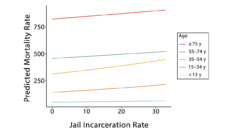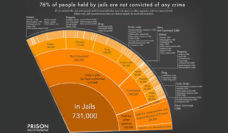The pervasive use of solitary confinement is a pressing human rights and public health issue that community activists, litigators, lawmakers and incarcerated people have been fighting to end for decades. Within state prisons, an estimated 55,000 to 62,500 people are languishing in solitary confinement on any given day.
People in solitary confinement are locked in a small cell for upwards of 22 hours per day. Access to programming and clinical care is severely restricted or non-existent. People only leave their cell to shower or exercise alone in caged or concrete enclosures. Making phone calls or receiving visits is not allowed, tightly regulated (through a glass pane), or cost-prohibitive for many families.
Incarcerated people live in a state of extreme isolation. Yet they have no privacy. Constant aversive sights, jarring sounds, and putrid odors are impossible to control or avoid. Time spent in solitary confinement ranges from days to weeks to months to years or even decades.
Extensive research has documented the profound and lasting harms of solitary confinement on mental and physical health. This evidence is the foundation of international human rights standards defining solitary confinement for longer than 14 days as torture. And it plays a prominent role in litigation, legislation, and advocacy efforts seeking to reduce or abolish the use of solitary confinement domestically.
A growing number of jurisdictions are taking action. In 2019 alone, 12 state legislatures passed and 28 introduced bills seeking to halt or limit solitary confinement. Research is critical for documenting harms, clarifying what states are doing to address solitary confinement, and evaluating the impacts of different policy interventions on the lives of directly impacted people.
I work for a program called Amend, based at the University of California, San Francisco that applies a public health and human rights framework to urgently address the debilitating harms of carceral environments on people who live and work in prisons. We conducted a mixed-methods case study to describe North Dakota’s ongoing quest to end solitary confinement and its impacts.
I met people who vividly recalled their traumas of spending years in solitary confinement and shared their progress in healing as a result of policy changes that got them out of isolation.
We found that, between 2016 and 2020, the number of people subjected to solitary confinement decreased by 74% in North Dakota’s two largest prisons. Both incarcerated people and staff experienced improvements in their lives as a result. I met people who vividly recalled their traumas of spending years in solitary confinement and shared their progress in healing as a result of policy changes that got them out of isolation.
Prison staff initially feared that releasing people from long-term solitary confinement and prohibiting it as a routine punishment would engender violence. Our analysis confirmed that their fears never materialized. Overall levels of violence in both prisons trended downward for five years following reforms.
Despite remarkable progress, North Dakota has not abolished solitary confinement. Staff receive better training. More behavioral health services are offered. And enhanced due process and transparency hold leadership more accountable. Yet, there are still spaces within these prisons where people spend a lot of time alone and dispirited.
It’s important to be candid about how incredibly hard it is to abolish a practice as old as the penitentiary itself. Litigation and legislation are vital catalysts, but often only a starting point. We cannot overlook the roles of people responsible for translating policy into practice. Engaging frontline prison staff who have the most day-to-day interactions with incarcerated people is an inevitable and critical step. They need to understand, believe, and experience the benefits of transformational change to become vessels of progress rather than agents of obstruction.
Most importantly, we need to amplify the voices of solitary confinement’s survivors. I have met and know many brilliant, resilient, artistic, and caring people inside these spaces who don’t belong in prison, whose fate was shaped by a collision of structural forces, unaddressed traumas, racism and historical injustices beyond their control.
Public health professionals have an unfulfilled duty to prevent and remedy the violence and health crises manifesting in the deepest ends of the carceral system. Our field has to have more accountability for what happens to those our health and social infrastructures have failed the most.
If you plan to devote your career to combatting health inequities, take some time to learn about the carceral institutions where you live, that your taxes fund. Get involved with the National Unlock the Box Campaign to see if there is a coalition in your community working to abolish solitary confinement. Let’s stop the torture taking place in our backyards and work toward creating a world without prisons.
Disclaimer: The views expressed in this post are my own and don’t necessarily reflect those of my professional affiliations or co-authors on the research article discussed.
Photo via Getty Images














